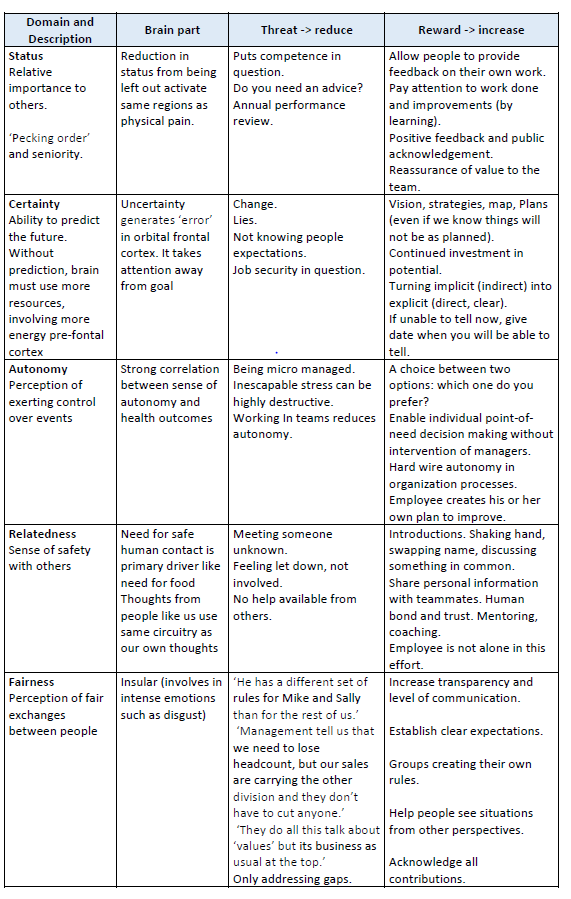
How can we cover the five domains (Status, Certainty, Autonomy, Relatedness and Fairness) in our change management project?

As a change lead, choose carefully your thoughts, wordings and actions. Every direction you make will either support or weaken the level perceived of one of the elements Status, Certainty, Autonomy, Relatedness or Fairness. The impact and perception varies from country to country due to the different communication patterns. Sentences, gestures and meanings are interpreted quite differently depending on the cultural types you are dealing with.
The SCARF model supports the change lead by raising the awareness to the interactions in a change program. This is not about whitewashing difficult and critical communication during a transition. An alignment towards reward leads to be more effective.
Based on the brain research, we understand that threat responses are stronger, prompt and hard to suppress. This is especially the case in stress situations, where the threat responses exceed reward responses. Consequently, people in a transformation program are blocked in their creativity. They will lack motivation, engagement, teamwork and making decisions.
Another conclusion from the brain research shows, that by identifying a threat response, it can reduce its impact on the brain. Hence, the mapping and monitoring of the five domains helps to regulate immediately our emotions.
The change lead will manage much smother a change and transformation program if the focus is on minimizing threat responses and maximizing rewards where possible. Since a model and real life will be different, you may want to take a threat in one domain when you know that you will gain a reward in another domain.
Personal experience
There are many unspoken rules in different cultures and projects. The SCARF model supported me not only in words, which are perceived as threat or reward, but also hearing messages between the lines. Just as reaction, often unspoken and visible by body language and behavior. Often, the most important things in conversations is to hear what is not being said.
To put theory in practice, let us look at the reaction of the body and emotion when I have applied the SCARF model in challenging transformation projects. You can compare the threat like using the power from your stomach whereas the reward is when you open your heart during a conflict instead of using your “stomach power”. The rewards feels in the beginning weaker than the threat but it gives a great sense of relief and more important, it lasts longer and beats the threat.
Recommendation
The SCARF model not only provides a way of bringing conscious awareness to our interactions, it helps us to become aware of our thoughts and emotions. We realize that we are not our thoughts and emotions. We have them and most of the time, thoughts and emotions dictate our life, such as threat responses. However, we do not consist only of our thoughts and emotions. Once we realize that difference, we care less about others who want to put us down (threat) or in a pleasant way, want to keep us encouraged (reward). We change the focus from outwards to inwards so that encouragement can raise from the inside and not from the outside. Our vision becomes clearer only when we can look into our own hearts. When we seek outside, we trap into illusions. If we seek inside, we liberate and face the truth.
References
- SCARF: a brain-based model for collaborating with and influencing others, Neuro Leadership Journal, 2008
- SCARF Research Summary, Neuro Leadership Institute, 2014
- Lieberman & Eisenberg (2008) The pains and pleasures of social life, Neuro Leadership Journal, Edition 1.
- Baumeister, R. F., Bratslavsky, E., & Vohs, K.D. (2001). Bad Is Stronger Than Good. Review of General
Psychology, 5(4), 323-370.


